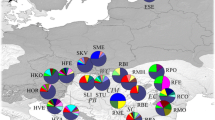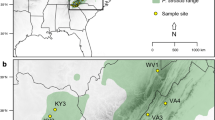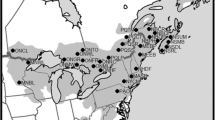Abstract
Molecular genetic markers may reveal informative patterns of population processes such as historical migration, which may substantiate inference on postglacial re-colonization inferred, e.g., from fossil records. Palynological records of Swiss stone pine (Pinus cembra) suggest that the species has re-colonized the central Alps from a southeastern Alpine refugium after the last glacial maximum. Such a migration pathway likely resulted in a gradual decrease in genetic diversity with increasing distance to the glacial refugium, owing to founder events at the leading range edge. The present distribution of P. cembra in Switzerland consists of two rather distinct ranges, namely the inner-alpine parts of the Grisons and Valais, respectively, and additional disjunct occurrences in the northern and southern periphery of the Alps as well as between the two main ranges. We screened chloroplast microsatellite loci on 39 Swiss P. cembra populations and show that the genetic structure detected was congruent with a common ancestry from a single glacial refugium, likely located at the (south-)eastern periphery of the Alps. In contrast, our data rejected the alternative hypothesis of a distinct genetic separation of the two main ranges of Swiss stone pine in Switzerland. We further show that low genetic diversity within and high differentiation among peripheral populations in the northern Alps as well as the genetic differentiation between core and peripheral populations reflect genetic drift as a consequence of colonization history and limited gene flow by pollen and seed.
Zusammenfassung
Molekulargenetische Marker enthalten wertvolle Information über Populationsprozesse wie historische Wanderungen, wodurch Annahmen zur postglazialen Wiederbesiedelung, beispielsweise abgeleitet von Fossilfunden, unterstützt werden können. Palynologische Funde von Arve (Pinus cembra) lassen vermuten, dass diese Art nach dem letzten glazialen Maximum von einem Refugium in den südöstlichen Alpen wieder in die zentralen Alpen eingewandert ist. Ein solcher Rückwanderungsweg dürfte aufgrund von Gründereffekten an der Wanderungsfront eine graduelle Verringerung der genetischen Variation mit zunehmender Distanz zum Glazialrefugium bewirkt haben. Die heutige Verbreitung von P. cembra in der Schweiz weist zwei deutlich getrennte Gebiete auf, nämlich inneralpine Bereiche der Kantone Graubünden und Wallis, mit jeweils isolierten Vorkommen in den nördlichen und südlichen Randalpen. Wir untersuchten Chloroplasten-Mikrosatelliten in 39 Schweizer Populationen von P. cembra und zeigen, dass die gefundene genetische Struktur übereinstimmt mit der Annahme einer gemeinsamen Abstammung aus einem einzigen Glazialrefugium, welches vermutlich am (süd-)östlichen Rand der Alpen lag. Im Gegensatz dazu widerlegen unsere Daten die alternative Hypothese einer deutlichen genetischen Trennung der zwei Hauptvorkommen der Arve in der Schweiz. Im Weiteren zeigen unsere Resultate eine geringe genetische Variation innerhalb und einen hohen Differenzierungsgrad zwischen nördlichen Randalpenvorkommen, sowie eine genetische Differenzierung zwischen zentralen und peripheren Populationen. Dies weist auf genetische Drift hin, welche die Besiedlungsgeschichte und einen beschränkten Genfluss durch Pollen und Samen widerspiegelt.



Similar content being viewed by others
References
Aizawa M, Yoshimaru H, Katsuki T, Kaji M (2008) Imprint of post-glacial history in a narrowly distributed endemic spruce, Picea alcoquiana, in central Japan observed in nuclear microsatellites and organelle DNA markers. J Biogeogr 35:1295–1307
Avise JC (2009) Phylogeography: retrospect and prospect. J Biogeogr 36:3–15
Belokon MM, Belokon YS, Politov DV, Altukhov YP (2005) Allozyme polymorphism of Swiss stone pine Pinus cembra L. in mountain populations of the Alps and the Eastern Carpathians. Russ J Genet 41:1268–1280
Brewer S, Cheddadi R, de Beaulieu J-L, Reille M, Data Contributors (2002) The spread of deciduous Quercus throughout Europe since the last glacial period. For Ecol Manage 156:27–48
Brussard PF (1984) Geographic patterns and environmental gradients: the central–marginal model in Drosophila revisited. Annu Rev Ecol Syst 15:25–64
Bucci G, Vendramin GG (2000) Delineation of genetic zones in the European Norway spruce natural range: preliminary evidence. Mol Ecol 9:923–934
Burga CA, Perret R (1998) Vegetation und Klima der Schweiz seit dem jüngeren Eiszeitalter. Ott, Thun
Cheddadi R, Vendramin GG, Litt T, François L, Kageyama M, Lorentz S, Laurent J-M, de Beaulieu J-L, Sadori L, Jost A, Lunt D (2006) Imprints of glacial refugia in the modern genetic diversity of Pinus sylvestris. Glob Ecol Biogeogr 15:271–282
Comps B, Gömöry D, Letouzey J, Thiébaut B, Petit RJ (2001) Diverging trends between heterozygosity and allelic richness during postglacial colonization in the European beech. Genetics 157:389–397
Dupanloup I, Schneider S, Excoffier L (2002) A simulated annealing approach to define the genetic structure of populations. Mol Ecol 11:2571–2581
Eckert CG, Samis KE, Lougheed SC (2008) Genetic variation across species’ geographical ranges: the central–marginal hypothesis and beyond. Mol Ecol 17:1170–1188
Excoffier L, Laval G, Schneider S (2007) Arlequin: a software for population genetic data analysis. Computational and Molecular Population Genetics Lab, University of Bern, Bern
Gapare WJ, Aitken SN, Ritland CE (2005) Genetic diversity of core and peripheral Sitka spruce [Picea sitchensis (Bong.) Carr] populations: implications for conservation of widespread species. Biol Conserv 123:113–123
Gehrig-Fasel J, Guisan A, Zimmermann NE (2007) Tree line shifts in the Swiss Alps: climate change or land abandonment? J Veg Sci 18:571–582
Gitzendanner MA, Soltis PS (2000) Patterns of genetic variation in rare and widespread plant congeners. Am J Bot 87:783–792
Gotelli NJ, Entsminger GL (2008) EcoSim: null models software for ecology. Acquired Intelligence and Kesey-Bear, Jericho
Gugerli F, Senn J, Anzidei M, Madaghiele A, Büchler U, Sperisen C, Vendramin GG (2001a) Chloroplast microsatellites and mitochondrial nad1 intron 2 sequences indicate congruent phylogeographic relationship of Swiss stone pine (Pinus cembra), Siberian stone pine (P. sibirica ), and Siberian dwarf pine (P. pumila). Mol Ecol 10:1489–1497
Gugerli F, Sperisen C, Büchler U, Magni F, Geburek T, Jeandroz S, Senn J (2001b) Haplotype variation in a mitochondrial tandem repeat of Norway spruce (Picea abies) populations suggests a serious founder effect during postglacial re-colonization of the western Alps. Mol Ecol 10:1255–1263
Gugerli F, Sperisen C, Mátyás G, Senn J, Anzidei M, Vendramin GG (2002) Molecular markers help to reveal postglacial re-colonisation routes of forest tree species in the Alpine region. In: Bottarin R, Tappeiner U (eds) Interdisciplinary mountain research. Blackwell, Berlin, pp 156–161
Hewitt GM (1996) Some genetic consequences of ice ages, and their role in divergence and speciation. Biol J Linn Soc 58:247–276
Hewitt GM (2000) The genetic legacy of the Quaternary ice ages. Nature 405:907–913
Hewitt GM (2004) Genetic consequences of climatic oscillations in the Quaternary. Phil Trans R Soc Lond B 359:183–195
Hilfiker K, Gugerli F, Schütz J-P, Rotach P, Holderegger R (2004) Low RAPD variation and female-biased sex ratio indicate genetic drift in small populations of the dioecious conifer Taxus baccata in Switzerland. Conserv Genet 5:357–365
Höhn M, Gugerli F, Abran P, Bisztray G, Buonamici A, Cseke K, Hufnagel L, Sebastiani F, Quintela-Sabarís C, Vendramin GG (2009) Variation in the chloroplast DNA of Swiss stone pine (Pinus cembra L.) reflects contrasting post-glacial history of populations from the Carpathians and the Alps. J Biogeogr. doi:10.1111/j.1365-2699.2009.02122.x
Lawton JH (1993) Range, population abundance and conservation. Trends Ecol Evol 8:409–413
Liepelt S, Bialozyt R, Ziegenhagen B (2002) Wind-dispersed pollen mediates postglacial gene flow among refugia. Proc Natl Acad Sci USA 99:14590–14594
Liston A, Robinson WA, Piñero D, Alvarez-Buylla ER (1999) Phylogenetics of Pinus (Pinaceae) based on nuclear ribosomal DNA internal transcribed spacer region sequences. Mol Phylogenet Evol 11:95–109
Magri D, Vendramin GG, Comps B, Dupanloup I, Geburek T, Gömöry D, Latalowa M, Litt T, Paule L, Roure JM, Tantau I, van der Knaap WO, Petit RJ, de Beaulieu J-L (2006) A new scenario for the Quaternary history of European beech populations: palaeobotanical evidence and genetic consequences. New Phytol 171:199–221
Manni F, Guérard E, Heyer E (2004) Geographic patterns of (genetic, morphologic, linguistic) variation: how barriers can be detected by “Monmonier’s algorithm”. Hum Biol 76:173–190
Mattes H (1990) Die Lebensgemeinschaft von Tannenhäher und Arve. Eidgenössische Forschungsanstalt für das forstliche Versuchswesen, Birmensdorf
Monmonier MS (1973) Maximum-difference barriers: an alternative numerical regionalization method. Geogr Anal 5:245–261
Nei M (1973) Analysis of gene diversity in subdivided populations. Proc Natl Acad Sci USA 70:3321–3323
Parisod C (2008) Postglacial recolonisation of plants in the western Alps of Switzerland. Bot Helv 118:1–12
Petit R, Vendramin GG (2007) Plant phylogeography based on organelle genes: an introduction. In: Weiss S, Ferrand N (eds) Phylogeography of Southern European refugia—Evolutionary perspectives on the origins and conservation of European biodiversity. Springer, Dordrecht, pp 23–97
Petit RJ, Csaikl UM, Bordács S, Burg K, Coart E, Cottrell J, van Dam B, Deans JD, Dumolin-Lapègue S, Fineschi S, Finkeldey R, Gillies A, Glaz I, Goicoechea PG, Jensen JS, König AO, Lowe AJ, Madsen SF, Mátyás G, Munro RC, Olalde M, Pemonge M-H, Popescu F, Slade D, Tabbener H, Taurichini D, de Vries SGM, Ziegenhagen B, Kremer A (2002) Chloroplast DNA variation in European white oaks: phylogeography and patterns of diversity based on data from over 2600 populations. For Ecol Manage 156:5–26
Petit RJ, Aguinagalde I, de Beaulieu J-L, Bittkau C, Brewer S, Cheddadi R, Ennos R, Fineschi S, Grivet D, Lascoux M, Mohanty A, Müller-Starck G, Demesure-Musch B, Palmé A, Martín JP, Rendell S, Vendramin GG (2003) Glacial refugia: hotspots but not melting pots of genetic diversity. Science 300:1563–1565
Petit RJ, Bialozyt R, Garnier-Gere P, Hampe A (2004) Ecology and genetics of tree invasions: from recent introductions to Quaternary migrations. For Ecol Manage 197:117–137
Politov DV, Belokon MM, Maluchenko OP, Belokon YS, Molozhnikov VN, Mejnartowicz LE, Krutovskii KV (1999) Genetic evidence of natural hybridization between Siberian stone pine, Pinus sibirica Du Tour, and dwarf Siberian pine, P. pumila (Pall.) Regel. For Genet 6:41–48
Rikli M (1909) Die Arve in der Schweiz Neue Denkschr Schweiz Naturforsch Ges 44:1–455
Salzer K, Sebastiani F, Gugerli F, Buonamici A, Vendramin GG (2009) Isolation and characterization of eight polymorphic nuclear microsatellite loci in Pinus cembra L. Mol Ecol Res 9:858–861
Slatkin M (1995) A measure of population subdivision based on microsatellite allele frequencies. Genetics 139:457–462
Soltis DE, Morris AB, McLachlan JS, Manos PS, Soltis PS (2006) Comparative phylogeography of unglaciated eastern North America. Mol Ecol 15:4261–4293
Szmidt AE (1982) Genetic variation in isolated populations of Stone Pine (Pinus cembra). Silva Fenn 16:196–200
Tollefsrud MM, Kissling R, Gugerli F, Johnsen Ø, Skroppa T, Cheddadi R, van der Knaap P, Latalowa M, Terhürne-Berson R, Litt T, Geburek T, Brochmann C, Sperisen C (2008) Genetic consequences of glacial survival and postglacial colonization in Norway spruce: combined analysis of mitochondrial DNA and fossil pollen. Mol Ecol 17:3134–3150
Tomback DF, Holtmeier F-K, Mattes H, Carsey K, Powell ML (1993) Tree clusters and growth form distribution in Pinus cembra, a bird-dispersed pine. Arctic Alpine Res 25:374–381
Tribsch A (2004) Areas of endemism of vascular plants in the Eastern Alps in relation to Pleistocene glaciation. J Biogeogr 31:747–760
Tutin TG, Burges NA, Chater AO, Edmonds JR, Heywood VH, Moore DM, Valentine DH, Walters SM, Webb DA (eds) (1993) Flora Europaea. Cambridge University Press, Cambridge
Vendramin GG, Lelli L, Rossi P, Morgante M (1996) A set of primers for the amplification of 20 chloroplast microsatellites in Pinaceae. Mol Ecol 5:595–598
Zimmermann N, Gugerli F (2005) Linking intra-specific diversity and habitat suitability—a case study using Pinus cembra L. In: Proceedings of the International Botanical Congress, Vienna, July 17–23, p 212
Zoller H (1991) Pinus. In: Conert HJ, Hamann U, Schultze-Motel W, Wagenitz G (eds) Gustav Hegi—Illustrierte Flora von Mitteleuropa. Blackwell, Berlin, pp 77–83
Acknowledgments
We thank Sabine Brodbeck for support in the lab, and Rolf Holderegger as well as the anonymous reviewers and Christian Parisod for comments on the manuscript. We are grateful to local forest services and forest owners for permission to sample plant material.
Author information
Authors and Affiliations
Corresponding author
Additional information
Responsible Editor: Christian Parisod.
Electronic supplementary material
Below is the link to the electronic supplementary material.
Rights and permissions
About this article
Cite this article
Gugerli, F., Rüegg, M. & Vendramin, G.G. Gradual decline in genetic diversity in Swiss stone pine populations (Pinus cembra) across Switzerland suggests postglacial re-colonization into the Alps from a common eastern glacial refugium. Bot. Helv. 119, 13–22 (2009). https://doi.org/10.1007/s00035-009-0052-6
Received:
Accepted:
Published:
Issue Date:
DOI: https://doi.org/10.1007/s00035-009-0052-6




